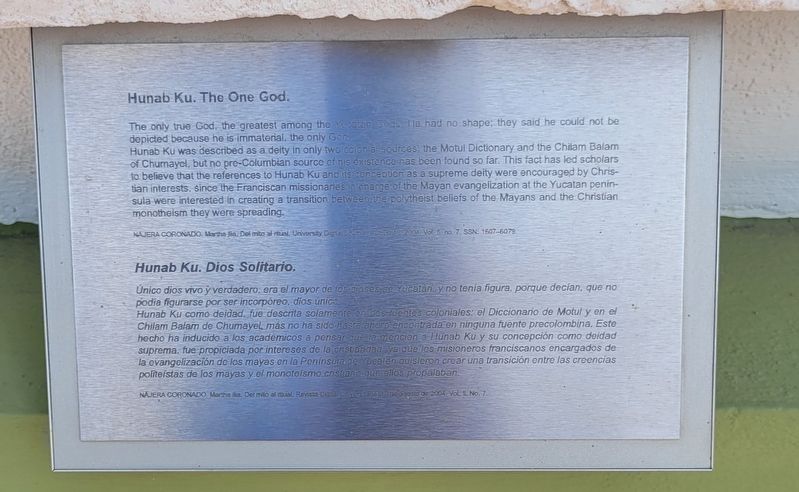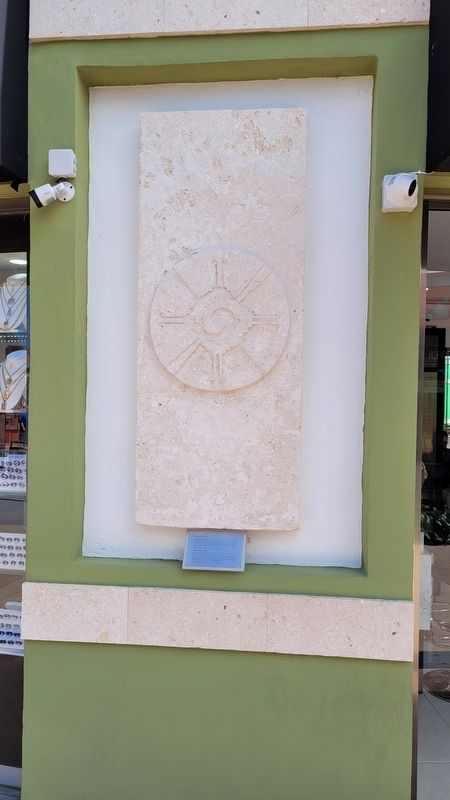San Miguel de Cozumel in Cozumel, Quintana Roo, Mexico — The Yucatan Peninsula (The Southeast)
Hunab Ku, The One God / Hunab Ku, Dios Solitario
Inscription.
The only true God, the greatest among the Yucatan Gods. He had no shape; they said he could not be depicted because he is immaterial, the only God.
Hunab Ku was described as a deity in only two colonial sources; the Motul Dictionary and the Chilam Balam of Chumayel, but no pre-Columbian source of his existence has been found so far. This fact has led scholars to believe that the references to Hunab Ku and its conception as a supreme deity were encouraged by Christian interests, since the Franciscan missionaries in charge of the Mayan evangelization at the Yucatan peninsula were interested in creating a transition between the polytheist beliefs of the Mayans and the Christian monotheism they were spreading.
NAJERA CORONADO, Martha Ilia, Del mito al ritual, University Digital Magazine, August 10, 2004 Vol. 5 no. 7. SSN: 1607-6079.
Spanish:
Hunab Ku como deidad, como deidad, fue descrita solamente en dos fuentes coloniales; el Diccionario de Motul y en el Chilam Balam de Chumayel, más no ha sido hasta ahora encontrada en ninguna fuente precolombina. Este hecho ha inducido a los académicos a pensar que la mencion a Hunab Ku y su concepción como deidad suprema, fue propiciada por intereses de la cristandad, ya que las misioneros franciscanos encargados de la evangelización de los mayas en la Península de Yucatan quisleron crear una transición entre las creencias politeístas de los mayas y el monoteismo cristiano que ellos propalaban.
NAJERA CORONADO, Martha Ilia, Del mito al ritual. Revista Digital Universtaria, 10 de agosto de 2004, Vol. 5. No. 7.
Topics. This historical marker is listed in these topic lists: Churches & Religion • Native Americans.
Location. 20° 28.714′ N, 86° 58.432′ W. Marker is in San Miguel de Cozumel, Quintana Roo, in Cozumel. Marker is at the intersection of Carretera Costera Sur and Av Claudio Canto on Carretera Costera Sur. The marker is located in central section of the International Cruise Terminal Cozumel. Touch for map. Marker is in this post office area: San Miguel de Cozumel QR 77675, Mexico. Touch for directions.
Other nearby markers. At least 8 other markers are within walking distance of this marker. Chak Mo'ol (a few steps from this marker); Kimi, God of Death / Kimi, Dios de la muerte (within shouting distance of this marker); Temple of Kukulkán, Chichén Itzá, Yucatan
(within shouting distance of this marker); The Temple of the Cross / El templo de la Cruz (within shouting distance of this marker); Tzolkin (within shouting distance of this marker); Haab (within shouting distance of this marker); K'uk'ulkan, Feathered Serpent / K'uk'ulkan, Serpiente emplumada (within shouting distance of this marker); Land of Chocolate (approx. 0.3 kilometers away). Touch for a list and map of all markers in San Miguel de Cozumel.
Also see . . . Hunab Ku. Wikipedia
Hunab Ku is a colonial period Yucatec Maya reducido term meaning "The One God". It is used in colonial, and more particularly in doctrinal texts, to refer to the Christian God. Since the word is found frequently in the Chilam Balam of Chumayel, a syncretistic document heavily influenced by Christianity, it refers specifically to the Christian God as a translation into Maya of the Christian concept of one God, used to enculturate the previously polytheist Maya to the new religion.(Submitted on January 13, 2024, by James Hulse of Medina, Texas.)
Credits. This page was last revised on January 13, 2024. It was originally submitted on January 13, 2024, by James Hulse of Medina, Texas. This page has been viewed 46 times since then. Photos: 1, 2. submitted on January 13, 2024, by James Hulse of Medina, Texas.

